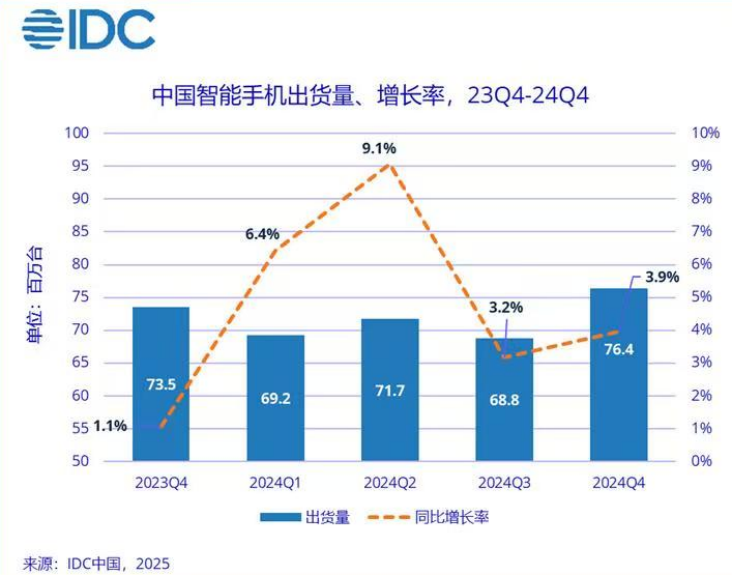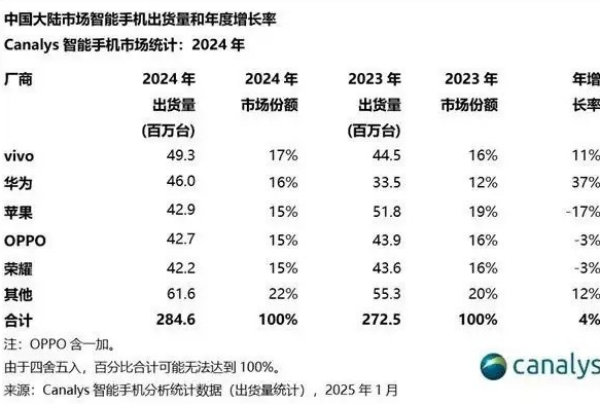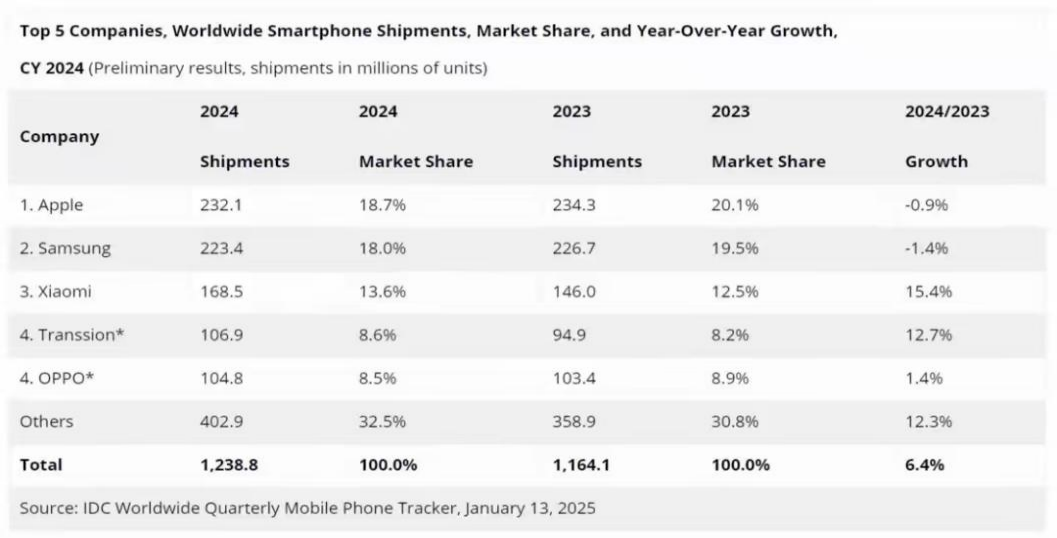2025 Mobile Phone Manufacturers' Landscape: Changes, Going Abroad, and Large Batteries
![]() 04/22 2025
04/22 2025
![]() 516
516
The landscape of mobile phone manufacturers in the second half of the market can be summarized by three keywords: changes, going abroad, and large batteries.
Content/Sophisticated
Editor/Yibai
Proofreader/Yong'e
Entering April 2025, the mobile phone industry has once again become fiercely competitive. First, OPPO released its flagship on the 10th, then Huawei began selling its low-end models, on the 15th, Honor unveiled an 8000mAh large battery phone, and it is said that vivo will also join in the fun at the end of the month.
After more than a decade of fierce competition, smartphone manufacturers have never given up their vigilance towards each other. A new marathon officially kicked off in 2025, with a tense atmosphere comparable to the adjacent new energy vehicle racetrack.
However, unlike previous years, Huawei's return has added some uneasy sentiments to its competitors this year. On the one hand, more and more consumers are choosing Huawei brands, and on the other hand, other manufacturers are striving to go abroad while sticking to their fundamentals. As for hardware parameters or technology, they still have to compete.
So far, the landscape of mobile phone manufacturers in the second half of the market can be summarized by three keywords: changes, going abroad, and large batteries. What consumers care about is who will ultimately fare better in the market and who will be out?
Part.1
Changes
Huawei's Return, Who is Falling Behind
2024 was the first year of recovery for the "two-year frozen" smartphone market, with annual shipments reaching 286 million units, a year-on-year increase of 5.6%. This momentum continued into the first quarter of 2025, with shipments reaching 71.6 million units, a year-on-year increase of 3.3%, 1.8 percentage points higher than the global market.
Amid the recovery of the industry, technological innovations such as foldable screens and HarmonyOS, as well as consumer subsidy policies in various regions, have released pent-up demand for phone replacements. However, this "spring" is not evenly distributed—Huawei's strong return is like a boulder stirring up drastic turbulence in market share.

Amid signs of overall recovery in the mobile phone industry, different manufacturers have presented a mixed picture of joy and sorrow. According to institutional data, Huawei's shipments surged 37% year-on-year in 2024, reaching 46 million units, returning to second place in the market (Huawei internally claims to have returned to first place); vivo topped the list with a 17% share, Honor fell to fifth, and Apple's market share declined by 17% year-on-year, with its dominant position in the high-end market being "ground into the dirt" by domestic brands.

Even in the first quarter of this year, Huawei's market share expanded by 1% year-on-year, OV's share continued to be suppressed, Honor disappeared from the rankings, and Apple continued to decline.

Behind these changes is the "butterfly effect" triggered by Huawei's return.
Considering that 60% of sales in the current Chinese mobile phone market rely on offline channels, Huawei's return has directly impacted the channel foundations of other brands.
"The return of Mate60 in 2023 was just the beginning. The real blockbuster was the nova13 series launched in the latter half of last year, marking a more comprehensive return of 5G phones. Huawei's internally launched plan to top the head merchant share and the strong merchant plan for the sinking market are directly causing other brands' channels to shrink and sales to decline," said a distributor from Zhejiang.
By seizing the share of top manufacturers and regaining the double channel plan of the sinking market, Huawei has dealt a heavy blow to other brands, such as OV, whose periodic dividends from eating the window period are disappearing.
In addition, Huawei requires core distributors to purchase IoT products such as smartwatches, headphones, and tablets simultaneously when picking up popular models, thereby strengthening brand loyalty. Although this increases inventory pressure, Huawei's comprehensive gross profit margin for channel partners reaches 8% to 12%, far exceeding OV's 5% to 10%.
"Huawei's sales share in our system has soared from 12% last year to 40%, and its profit contribution often exceeds the sum of other brands. OV can only rely on price reductions to clear inventory. Even the secondary market price of high-end phones drops by more than 20% one month after their release," said a distributor.
In response to Huawei's squeeze, OV has also tried to introduce rent subsidy policies. For example, in some developed provinces, OPPO provides two years of rent subsidies for new stores, while vivo shares costs through after-sales subsidies. But even so, some former OV and Honor channel partners have shifted funds to Huawei to compete for the premium dividend of the Mate series. Since the end of last year, the original customer coverage and pick-up volume have declined significantly.
As for Honor, the decline is even more pronounced.
In the first quarter of 2024, Honor topped the domestic camp with a 17.1% share, but with the full return of Huawei's 5G phones, Honor's "flat replacement" positioning quickly became ineffective, so that its current share is not even on the table.
Apple's share in China's high-end market (above $600) fell from 80% in 2023 to 52% in 2024, while Huawei surged from 7% to 33% over the same period.
Behind the appearance, the fundamental reason for the gradual decline of other brands is the prominent role of Huawei's multiple competitive advantages.
Huawei has powerful self-developed chips and the ability to create gradually localized technological differentiation (such as satellite calls, HarmonyOS construction, Kunlun glass, etc.), coupled with an annual R&D investment of about 20%, resulting in continuous improvement of its brand power and product appeal. Other brands often can only follow suit in their high-end sprint, while in the mid-to-low-end market, they have to engage in price wars within their respective camps.
What's more deadly is that these brands' offline channels are highly dependent on Huawei's legacy dealer network. When Huawei models obtain higher premiums due to scarcity, consumers naturally lean towards Huawei. A simple example is the decline in market share and the departure of senior executives such as Zhao Ming, Honor's CEO, exposing the pain brought to the original manufacturer after the "transfer of brand loyal users."
Only Xiaomi is doing better due to its strategy of "one county, one merchant" and opening independent stores. The problem is that it mainly relies on top customers, and its comprehensive gross profit margin is about 10%, far from Huawei's contribution profit, which starts at 30% for some top merchants. In addition, although Xiaomi has gained momentum in the short term due to the popularity of new energy vehicles, it is still a mystery whether its mobile phone shipments will continue to increase.
As vivo Vice President Hu Baishan said, "Huawei is just taking back the position that should belong to it. In the next 2 to 3 years, competition will be extremely intense." Indeed, in the changing landscape of mobile phone manufacturers continuously competing for market share, it is also obvious who is falling behind. Leaving Apple aside, how should other domestic brands choose to respond to this dilemma?
While consolidating the domestic fundamentals, accelerating going abroad has become one of the preferred options for domestic manufacturers.
Part.2
Going Abroad
Every Manufacturer is Competing for the Cake
In 2025, almost every Chinese mobile phone brand is looking outward. Given the fierce competition in the domestic market, the overseas market is only ongoing, with no end in sight. Even Huawei is ready to do sth .
The opportunities overseas are also huge. IDC data predicts that global smartphone shipments will reach 1.27 billion units in 2025, with a year-on-year growth rate approaching 3%. Coupled with the potential continued explosion of AI phones, the global market will be a blue ocean.

This has led to the second landscape of mobile phone manufacturers: accelerating going abroad.
Huawei's performance once approached the world's first place, Honor's overseas market also matched its performance share with the Chinese region in December last year (5:5), OPPO's overseas revenue share exceeded 45% for the first time, vivo vowed to increase its overseas revenue share to 70% within two years, and Xiaomi's sales are also mainly overseas.
Let's start with Huawei. The Huawei Pura 70 series, released as early as April 2024, has already been shipped to more than 60 countries and regions. However, considering that it is still a sanctioned company, it will still be limited by the lack of GMS services in major overseas markets, and its focus may continue to be on the domestic market in the short term.
Huawei's 2024 annual report revealed that China's revenue accounted for 71% of its total revenue. It can be inferred that compared with the domestic market, the terminal business has not yet formed an effective scale overseas.
As for other brands, they can obviously be bolder and more aggressive.
Honor adopts a differentiated approach, focusing on the "high-end + regional focus" strategy. For example, the Honor Magic V3 series topped the Western European foldable screen market with a 35% share in Q2 2024. In emerging markets such as Southeast Asia, Honor enhances user experience by pre-installing locally popular applications (such as Indonesia's GoTo ecosystem) and focusing on digital series. In 2025, when Honor enters the Indonesian market, it plans to open 10 brand experience stores and continue to expand its layout in the American market.
OPPO attempts to meet the in-depth localization needs of the supply chain through the "Glocal" strategy, while targeting Apple with high-end models.
Taking the Thai market as an example, OPPO launched a customized Reno series optimized for battery cooling in tropical climates and topped the local market with a 20% share in Q3 2024; in terms of high-end models, last year's straight-screen flagship Find X8 series achieved significant sales results in multiple countries and regions such as Asia-Pacific, Europe, and Latin America, with sales exceeding 500,000 units in the European market upon its first sale; in 2025, OPPO will also increase the construction of overseas offline zones.
vivo pays more attention to a long-term localization operation strategy. Public information shows that the brand is committed to achieving full-link localization through the "More Local, More Global" strategy. For example, vivo has 95% local employees in India, and the localization rate of components also exceeds 60%. In 2025, vivo plans to add 5 factories in Indonesia to further enhance local production capacity, while increasing the overseas sales share of the high-end X200 series to 40%.
Xiaomi ranked third in global smartphone market share in Q1 this year, consolidating emerging markets with cost-effectiveness while entering developed markets with high-end models.
In markets such as India and Southeast Asia, the Redmi Note series has long occupied the top sales position, with global shipments exceeding 80 million units in Q4 2024; in March this year, Xiaomi also officially entered South Korea, launching the Xiaomi 15 Ultra, which sold out upon its first sale, driving the Korean market share from 0% to 8%; in the European market, Xiaomi promotes the "Xiaomi Ecosystem +" model, where users can enjoy an 8% discount on ecosystem products when purchasing mobile phones, thereby increasing the average order value; in addition, Xiaomi also plans to establish 10,000 Xiaomi Homes overseas from 2025 to 2029 to build a global distribution network.
It can be said that each brand has both competition and differentiated approaches overseas, but the ultimate goal is to enhance the mobile phone experience. Judging from recent trends, manufacturers seem to be aiming at this point: batteries.
Part.3
Large Batteries
A New Challenge for Manufacturers' Internal Competition
'I'd rather have a thicker phone with a larger battery,' this is the common expectation of many domestic and foreign netizens towards mobile phone manufacturers.
A user survey on Douyin showed that among the purchase decisions for 7000mAh battery phones, the core demand for "one charge per day" accounted for up to 68%.
In response, manufacturers' tactical choices are also clearly differentiated:
The Red Magic 10 PRO's 7050mAh Bull Demon battery and the Redmi Turbo 4 Pro's 7500mAh ultra-large battery attract geek users with "parameter crushing," but the body thickness is generally over 9mm.
OPPO Find X8 Ultra adopts a combination of "silicon-carbon anode + graphene heat dissipation," achieving 125W super flash charging in a 6100mAh battery, with 40% battery life restored in 10 minutes of charging.
Honor Power directly increases the battery capacity to 8000mAh and finds a compromise between battery life and hand feel. Coupled with the "national subsidy" policy, the starting price is reduced to 1699 yuan, realizing technology for the benefit of the people.
This differentiation reflects the deep contradictions in the industry. Consumers desire "no anxiety about battery life," but manufacturers are constrained by material costs (the unit price of silicon-carbon anode is three times that of graphite) and safety risks. More subtly, some manufacturers use large batteries as a "pseudo-innovation"—a certain thousand-yuan phone is equipped with a 7000mAh battery, but its screen brightness is only 300 nits, and its actual battery life is inferior to a competitor's 5000mAh model.
After more than a decade of development, batteries and battery life have become far more important than camera experience in smartphones, which is a similar principle to new energy vehicles. Battery life is as crucial as intelligence level. However, it is still unknown whether the increase in battery capacity means a real improvement in phone battery life.
Battery life is a common pain point for consumers, which is more practical than AI. For each manufacturer, AI is like distant water that cannot put out the intense near fire of competition. In that case, it is better to turn to directions that can truly solve user pain points.
As IDC analyst Will Wong warned, "When all manufacturers are telling AI stories, the real competition will return to the most basic experience." Among them, batteries naturally "bear the brunt." Before AI has not yet landed and produced killer applications, being able to use an extra 5 hours has become a key focus for consumers. From this perspective, large batteries are worth manufacturers' internal competition.
Huawei is restructuring the landscape with technological advantages, Xiaomi is betting on AI and globalization, while OPPO and vivo need to find a balance between channels and innovation. In the future, who can balance the domestic market and overseas expansion, and who can break through the practical bottlenecks of batteries and AI will survive this decade-long battle.







